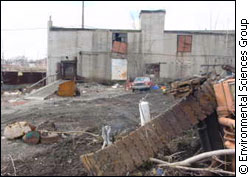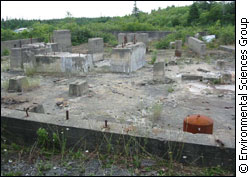|
Finding
the real risks
of contaminated sites
By Nathan Kim
OTTAWA —
Canada has over 4,000 areas
that Health Canada has designated as contaminated. Along
with these sites there are around 30,000 designated
brownfield sites, which are contaminated areas that
may potentially be cleaned up and redeveloped.
 |
| Contaminated sites like this one
may not be as risky as they seem. |
But not all of these sites actually pose any risk to
people even though they contain toxin levels that are
supposedly unsafe, says Ken Reimer, director of the
Environmental Sciences Group at the Royal Military College
in Kingston.
Reimer says that although toxins may exist in an area,
the bioavailability of the toxin must be determined
before one can know just how dangerous the site may
be to people.
Bioavailability is the amount of the toxin that is
actually absorbed in the human bloodstream and is therefore
potentially dangerous to people.
Finding the real risk
Reimer says there are three stages that he and his
team of scientists work through when dealing with contaminated
areas.
The first step is site assessment, or determining just
how contaminated the area is. The second step is finding
out exactly how much of a risk the area poses to people
or animals and lastly, what can be done to clean up
the site.
Reimer says much of his work is focused on the second
step.
Because the concept of bioavailability and risk assessment
is quite new, Reimer says that a lot of his team's work
is to find new ways to determine how much of the existing
toxins may actually pass into a person's bloodstream.
The team has developed a new technique which involves
simulating the chemical composition of the various stages
of the human digestive system in containers in a laboratory,
and then shaking samples from contaminated sites in
the containers to see how much of the toxin would be
dissolved and potentially absorbed if ingested by a
person.
Reimer says this test was used to explain why animals
and people did not seem to be affected by elevated levels
of arsenic found in Yellowknife, North West Territories.
| 'If you did a
conventional risk assessment, the mice living near
the mine should all be dead' |
Yellowknife has naturally elevated arsenic levels that
are as high as 150 parts per million. The acceptable
levels of arsenic in soil, as outlined by Health Canada,
is only 12 parts per million. Despite the high levels
of the toxin, Reimer's team noticed that mice populations
were flourishing near mines where toxin levels were
often even higher.
"If you did a conventional risk assessment, the
mice living near the mine should all be dead,"
Reimer says.
The conventional risk assessment only considered toxin
levels and did not look at how much of the area's toxins
were actually absorbed by people or animals. Reimer's
team found that only five per cent of the available
toxin in soil samples was dissolved by the body, even
if directly ingested. This meant that there was actually
little risk to people in Yellowknife, despite the alarmingly
high levels of arsenic.
Cleaning the mess
 |
| Plants may play a major role in
cleaning up contaminated sites in the future. |
Reimer's team is also conducting research into what
can be done when contaminated sites are found to pose
a risk to people.
The team is focusing on biological agents, such as
microscopic organisms or plants, to clean up problem
areas.
"Typically, soil from contaminated sites is dug-up
and sent to incinerators which is very expensive,"
Reimer says. "We've had good success in using plants
in remediation."
Reimer points out a resent study that found certain
types of grasses and pumpkins proved particularly good
at absorbing toxins released during transformer fluid
spills which, at high levels, can cause neurological
problems in people.
Treating the public
By
showing just how much risk the contamination may actually
pose and offering inexpensive ways to clean up sites,
Reimer recognizes he is in a position to help change
people's perception on dealing with this widespread
concern.
| 'It's remarkably
comforting for people when they see the actual risk
factor in numbers.' |
"I think it is really important to alleviate some
of the fears in the public," Reimer says. "We've
found we’ve been very successful with this. It’s
a remarkably comforting for people when they see the
actual risk factor in numbers."
Reimer says he is also trying to teach policy makers
that just because a site is contaminated it may not
be hazardous and that expensive soil cleaning methods
may not be necessary.
Reimer says governments are wasting money and resources
trying to cleanup sites that pose little or no risk
to people.
"Bioavailability should be the cause for action,"
says Reimer. "Right now, the total amount of contaminants
is used to determine action."
Still, Reimer says the concept of bioavailability is
slowly catching on. A new organization called Bioaccessibility
Research Canada was created in August 2004 to evaluate
on the risk factor of contaminated sites, not just the
fact that they are contaminated.
|